Shandong
 From Nwe
From Nwe | 山东省 Shāndōng Shěng |
|
| Abbreviations: 鲁 (Pinyin: Lǔ) | |
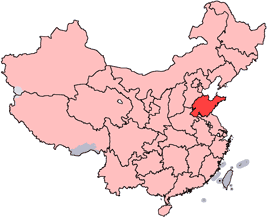 |
|
| Origin of name | 山 shān - mountain 东 dōng - east "east of the Taihang Mountains" |
| Administration type | Province |
| Capital (and largest city) |
Jinan |
| CPC Ctte Secretary | Jiang Yikang |
| Governor | Jiang Daming |
| Area | 157168 km² (20th) |
| Population (2010) - Density |
95,793,065 (2nd) 609.5/km² (5th) |
| GDP (2011) - per capita |
CNY 4.50 trillion US$ 711 billion (3rd) CNY 47,260 US$ 7,317 (9th) |
| HDI (2008) | 0.828 (high) (8th) |
| Major nationalities | Han - 99.3% Hui - 0.6% |
| Prefecture-level | 17 divisions |
| County-level | 140 divisions |
| Township-level† | 1941 divisions |
| ISO 3166-2 | CN-37 |
| Official website http://www.sd.gov.cn (Simplified Chinese) |
|
| Source for population and GDP data:
《中国统计年鉴—2005》 China Statistical Yearbook 2005 Source for nationalities data:
ISBN 7503747382
《2000年人口普查中国民族人口资料》 Tabulation on nationalities of 2000 population census of China † As at December 31, 2004ISBN 7105054255 |
|
Shandong (Simplified Chinese: 山东; Traditional Chinese: 山東; pinyin: Shāndōng; Wade-Giles: Shan-tung) is a province of the People's Republic of China, located on the eastern coast of the country. The province is located at the lower reaches of the Huanghe (Yellow River) and extends out to sea in the form of the Shandong Peninsula. Shandong borders the Bohai Bay to the north, Hebei to the northwest, Henan to the west, Jiangsu to the south, and the Yellow Sea to the southeast. It also shares a very short border with Anhui, between Henan and Jiangsu.
Shandong's name literally means mountains' east, which refers to the province's location east of the Taihang Mountains. Its abbreviation is Lu, after the state of Lu that existed here during the Spring and Autumn Period of Chinese history. A common nickname for Shandong is Qílǔ (齐鲁/齊魯), after the state of Lu and state of Qi that existed here during the Spring and Autumn Period.
Shandong's location on the ocean, with mountains, abundant plains, and the Yellow River flowing through along with the Grand Canal of China, cast the province into a central role in Chinese history. The first city existed in Shandong, and the region played a central role in the succession of Chinese dynasties. In the nineteenth and twentieth centuries, Germany put the province in its sphere of influence, while Great Britain took control of a port city. Japan invaded and controlled the province from 1937, until liberation in 1945. The province played a central role under communist rule. Now, with China's shift to free enterprise, Shandong's diverse natural resources, natural beauty, as well as strategic location with its many ports, has propelled its economy into one of the top in China.
History
Shandong is located on the eastern edge of the North China Plain, and as a result it has felt the influence of Chinese civilization since its very beginnings. The earliest dynasties (the Shang dynasty and Zhou dynasty) exerted varying degrees of control over western Shandong, while eastern Shandong was inhabited by the Laiyi peoples, who were considered to be barbarians. Over subsequent centuries, the Laiyi were eventually sinicized.
During the Spring and Autumn Period and the Warring States Period, regional states became increasingly powerful. Shandong was at this time home to two powerful states: The state of Qi at Linzi and the state of Lu at Qufu. Lu is significant because it is known for being the home of Confucius. The state was, however, comparatively small, and eventually succumbed to the powerful state of Chu from the south. The state of Qi was, on the other hand, a major power throughout this entire period. Cities it ruled included Linzi, Jimo (north of modern Qingdao) and Ju.
The Qin Dynasty eventually destroyed Qi and founded the first centralized Chinese state in 221 B.C.E. The Han Dynasty that followed created two zhou ("provinces") in what is now modern Shandong: Qingzhou Province in the north and Yanzhou Province in the south. During the division of the Three Kingdoms Shandong belonged to the Kingdom of Wei, which ruled over northern China.
After the Three Kingdoms period, a brief period of unity under the Western Jin Dynasty gave way to invasions by nomadic peoples from the north. Northern China, including Shandong, was overrun. Over the next century or so Shandong changed hands several times, falling to the Later Zhao, then Former Yan, then Former Qin, then Later Yan, then Southern Yan, then the Liu Song Dynasty, and finally to the Northern Wei Dynasty, the first of the Northern Dynasties during the Northern and Southern Dynasties Period. Shandong remained under the control of the Northern Dynasties for the remainder of this period.
In 412, the Chinese Buddhist monk Faxian landed at Laoshan, on the southern edge of the Shandong peninsula, and proceeded to Qingzhou to edit and translate the scriptures he had brought back from India.
The Sui Dynasty reestablished unity in 589, and the Tang Dynasty (618-907) presided over the next golden age of China. For the earlier part of this period, Shandong was ruled as part of Henan Circuit, one of the circuits, or political divisions at the time. Later on, China splintered into warlord factions, resulting in the Five Dynasties and Ten Kingdoms period. Shandong was part of the Five Dynasties, all based in the north.
The Song Dynasty reunified China in the late tenth century, but was later forced to cede northern China to the Jurchen Jin Dynasty in 1142. Shandong was then administered by the Jin Dynasty as Shandong East Circuit and Shandong West Circuit, which marked the first use of its current name.
While the region was given its current name at that time, it was not made into a modern province until the Ming Dynasty. At that point it also included much of modern-day Liaoning, which was located in south Manchuria) at the time. However, the Manchus increasingly asserted independence, and managed to conquer all of China in 1644. Under the Qing Dynasty which they founded, Shandong more or less acquired its current borders.

During the nineteenth century, China became increasingly exposed to Western influence, and Shandong, a coastal province, was especially affected. Qingdao was leased to Germany in 1897 and Weihai to Britain in 1898. The rest of Shandong was generally considered to be part of the German sphere of influence. In addition, the Qing Dynasty opened Manchuria to Han Chinese immigration during the nineteenth century, and Shandong was the main recipient of the ensuing tide of migrants.
After the Republic of China was founded in 1911, Qingdao reverted to Chinese control in 1922, and Weihai followed in 1930. In 1937, Japan began its invasion of the Chinese mainland in the Second Sino-Japanese War, which would eventually become part of the Pacific theater of the Second World War. Shandong played a major role in this invasion, as it was occupied in its entirety by Japan, with the only resistance coming from the countryside. This occupation lasted until the surrender of Japan in 1945.
By 1945, communist forces already held large portions of Shandong. Over the next four years of the Chinese Civil War, they expanded their holdings, eventually driving the Kuomintang (government of the Republic of China) entirely out of Shandong by June 1949. The People's Republic of China was founded in October that year.
Under the new government, parts of western Shandong were initially given to the short-lived Pingyuan Province, but this did not last. Shandong also acquired the Xuzhou and Lianyungang areas from Jiangsu province, but this did not last either. For the most part, Shandong has kept the same borders that it currently has today.
In recent years, Shandong, especially eastern Shandong, has raced ahead in economic development, becoming one of the richest provinces of China and a symbol of the large scale economic development the country has undergone since the 1980s.
Geography

Shandong is mostly flat in terrain, especially since the northern, western, and southwestern parts of the province are all part of the North China Plain. The center of the province is more mountainous, with the Taishan Mountains, Lushan Mountains, and Mengshan Mountains being the most prominent ranges. The eastern part of the province (Shandong Peninsula) extends into the sea, separating the Bohai Sea in the northwest from the Yellow Sea to the east and south. The highest peak in Shandong is the highest peak in the entire Taishan area, Jade Emperor Peak, which has a height of 1,545 m.
The Yellow River passes through Shandong's western region, entering the sea along Shandong's northern coast. As it runs through Shandong it flows on a levee at a higher elevation than the surrounding land, and divides western Shandong into the Haihe watershed in the north and the Huaihe watershed in the south. The Grand Canal of China enters Shandong from the northwest and leaves in the southwest. Weishan Lake is the largest lake in the province. Shandong's coastline is 3,000 km long, and the Shandong Peninsula is characterized by its rocky coastline, with cliffs, bays, and islands. The large Laizhou Bay, the southernmost of the three bays of Bohai Sea, is found to the north, between Dongying and Penglai. Jiaozhou Bay, which is much smaller, is found to the south, next to Qingdao. The Miaodao Islands extend northwards from the northern coast of the peninsula.

Shandong has a temperate climate, with moist summers and cold, dry, winters. Average temperatures are -5 to 1°C in January and 24 to 28°C in July. Annual precipitation is 550 to 950 mm, although it is frequently affected by marine monsoons, especially during the summer time.
Along with Jinan, which serves as the province's economic and cultural center, Shandong's economic prowess has led to the development of modern coastal cities located at Qingdao, Weihai, and Yantai. Weifang and Zaozhuang are also upstart cities which have benefited from Shandong's enormous economic growth.
Major cities:
- Jinan
- Qingdao
- Weihai
- Yantai
- Weifang
- Zaozhuang
Major rivers and lakes:
- Yellow River
- Weishan Lake
- Dongping Lake
Administrative divisions
Shandong is divided into 17 prefecture-level divisions, all of them prefecture-level cities:
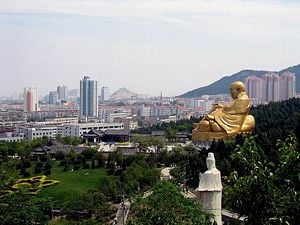
- Jinan (Simplified Chinese: 济南市; Traditional Chinese: 濟南市; Hanyu pinyin: Jǐnán Shì)
- Liaocheng (聊城市 Liáochéng Shì)
- Dezhou (德州市 Dézhōu Shì)
- Dongying (東營市 (东营市) Dōngyíng Shì)
- Zibo (淄博市) (Zībó Shì)
- Weifang (潍坊市 Wéifāng Shì)
- Yantai (煙臺市 (烟台市) (Yāntái Shì)
- Weihai (威海市 Wēihǎi Shì)
- Qingdao (青島市 (青岛市) Qīngdǎo Shì)
- Rizhao (日照市 Rìzhào Shì)
- Linyi (臨沂市 (临沂市) Línyí Shì)
- Zaozhuang (棗莊市 (枣庄市) Zǎozhuāng Shì)
- Jining (濟寧市 (济宁市) Jìníng Shì)
- Tai'an (泰安市) Tài'ān Shì)
- Laiwu (萊蕪市 (莱芜市) Láiwú Shì)
- Binzhou (濱州市 (滨州市) Bīnzhōu Shì)
- Heze (菏澤市 (菏泽市) Hézé Shì)
The seventeen prefecture-level divisions of Shandong are subdivided into 140 county-level divisions (49 districts, 31 county-level cities, and 60 counties). Those are in turn divided into 1,941 township-level divisions (1,223 towns, 293 townships, two ethnic townships, and 423 subdistricts).
Economy
Shandong ranks first among all of China's provinces in the production of a variety of products, including cotton and wheat. Other important crops include tobacco, sorghum and maize, as well as peanuts, for which the province is especially well-known, providing nearly a quarter of the entire country's total supply. Shandong is also a significant producer of fruit, and is famous for the apples of Yantai, the pears of Laiyang, the dates of Leling and the watermelons of Dezhou. Shandong also effectively utilizes its coastal position by producing salt from sea water, and by serving as one of the largest fisheries in China, providing significant amounts of fish, crabs, and kelp.
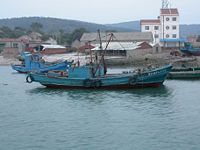
In addition to its agricultural resources, Shandong has extensive deposits of natural gas, iron, diamonds, and bauxite. Its output of gold also ranks first in all of China.
Shandong serves a strategic role for China due to its abundant petroleum deposits, which are especially concentrated in the Dongying area of the Yellow River delta. The Shengli Oilfield is one of the major oilfields of China, and provides a large quantity of petroleum to the rest of the nation. In total, the crude oil produced in Shandong makes up one-third of the nation’s total. Along with its strong petroleum reserves, the province has 50,000 square kilometers of coalfields, and its Yanteng coal mine is one of the nation’s ten major coal production bases. Both of these resources make Shandong an incredibly important energy producer for China.
Shandong is one of the richer provinces of China, and its economic development has been focused on large enterprises with well-known brand names. Shandong has also benefited from South Korean and Japanese investment, due to its geographical proximity to those countries. The richest part of the province is the Shandong Peninsula, where the city of Qingdao is home to two of the most well-known brand names of China: Tsingtao Beer and Haier. In addition, Dongying's oil fields and petroleum industries form an important component of Shandong's economy. Although the coastal areas have been blessed with tremendous economic prosperity, the extreme inland west of Shandong is much poorer than the rest of the province. This is consistent with a general trend in China, where the urban coastal areas have become much more affluent than the rural inland areas.
In 2004, the nominal GDP for Shandong was 1.55 trillion yuan (US$192.3 billion), ranking second in the country (behind Guangdong and ahead of Jiangsu).
Education
As would be expected from such an economically successful province, Shandong's education system has improved tremendously over the past 20 years. Since the reforms of 1979, Shandong has emphasized the development of higher education institutions, it has reorganized the structure of middle schools, and made the quality of education a key part of its educational reform process. According to figures from the end of 2000, there were 58 higher education institutions in Shandong, with 303,826 students enrolled and 54,910 teachers. There were also 4,475 secondary schools with 6,786,003 students enrolled and 430,745 teachers, and the province's 26,017 primary schools had a total of 7,748,822 students and 440,161 teachers. As Shandong continues to grow and expand economically, it is reasonable to expect that its education system will also follow along, providing the country with a strong pool of skilled and educated individuals.
Colleges and universities
- Shandong University (Jinan)
- Ocean University of China (Qingdao)
- University of Petroleum (Dongying)
Culture

Mandarin dialects are spoken throughout Shandong, and linguists classify these dialects into three broad categories: Ji Lu Mandarin spoken in the northwest (as well as in neighboring Hebei), Zhongyuan Mandarin spoken in the southwest (as well as in neighboring Henan), and Jiao Liao Mandarin spoken in the Shandong Peninsula (as well as the Liaodong Peninsula across the sea). When people refer to the "Shandong dialect" (山東話), they are generally referring to the first or the second, as the Jiao Liao dialects are commonly called the "Jiaodong dialect" (膠東話).
Shandong cuisine (鲁菜) is one of the eight great traditions of Chinese cuisine. It can generally be divided into three types, the inland Shandong cuisine (for example, Jinan cuisine), the seafood-centered Jiaodong cuisine in the peninsula, and the Confucius's Mansion cuisine, an elaborate tradition of cooking that was originally intended for Imperial feasts and other important events.
Shandong Bangzi and Lüju are popular types of Chinese opera in Shandong, and both originated from the southwestern region of the province.
Shandong is the second most populous province of China after Henan, with a total population of almost 92 million. Over 99 percent of this large population is Han Chinese, although there are several minority groups including the Hui and the Manchus.
Professional sports teams based in Shandong include:
- Chinese Football Association Super League
- Shandong Luneng
- Qingdao Zhongneng
- Chinese Football Association Jia League
- Qingdao Hailifeng
- Chinese Basketball Association
- Shandong Jinsidun Lions
Transportation
The Jingjiu Railway (connecting Beijing to Kowloon) and the Jinghu Railway (connecting Beijing to Shanghai) are both major railways that pass through the western part of Shandong. The Jingjiu passes through Liaocheng and Heze, while the Jinghu passes through Dezhou, Jinan, Tai'an, Qufu, and Tengzhou. The Jiaoji Railway is also an important railway of Shandong, linking its two largest cities, Jinan and Qingdao.
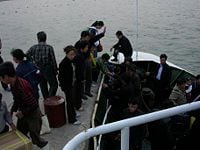
Shandong has one of the highest quality expressway networks among all of the Chinese provinces. At over 3,000 km, the total length of Shandong's expressways is the highest among all the provinces. The Jiqing Expressway (which connects Jinan to Qingdao) and the Jingfu Expressway (which connects Beijing to Fuzhou, both pass through Shandong) and serve as important expressway links for the rest of the country.
The Shandong Peninsula with its many bays and harbors, has many important ports including Qingdao, Yantai, Weihai, Rizhao, and Longkou. Many of these ports have historical significance as well, as the sites of former foreign naval bases or historical battles. Ferries link the cities on the north coast of the peninsula with the Liaodong Peninsula, further north across the sea.
In terms of air travel, two of Shandong's most important airports include Jinan Yaoqiang Airport and Qingdao Liuting International Airport.
Tourism
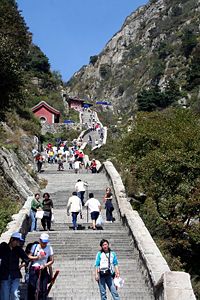
Shandong is a major tourist destination in China, with a variety of different sites to behold. The ruins of ancient Longshan, which is considered to be the earliest city in China, is one of the most important of these sites, along with Penglai, a town on the north of the Shandong peninsula which is well-known in Daoism.
Shandong is also blessed with beautiful landscapes, including the sacred Mount Taishan, Laoshan, which is a prominent center of Daoism, and the seaside of the Jiaodong peninsula. In 1987 and 1994, respectively, Mount Taishan, the Temple and Cemetery of Confucius, and the Confucius Mansion in Qufu were inscribed on the China World Cultural and Natural Heritage List by UNESCO, making them into internationally recognized sites.
Jinan, Shandong's provincial capital, is one of China's most famous historical and cultural cities. It has numerous natural springs, which provide it with its name, Spring City.
Shandong is also considered the birthplace of China's pottery, porcelain and silk. Throughout the province, tourists can find these as well as other traditional items like the clocks and watches of Yantai, the porcelain of Zibo, the kites of Weifang, and the shell-carving of Qingdao. Qingdao is also a beach resort city which is famous for its Tsingtao beer. Other famous sites in the province include: Qingzhou, an ancient trading and administrative center with some famous archaeological discoveries, and Weihai, a former British port city which was important during the second Sino-Japanese War.
-

Old pine tree near the Four-Gates Pagoda in Shandong Province, China.
-

Carved sculptures on the Thousand Buddha Cliff in Shandong Province, China.
-

sunrising on the Changshan islands sea area
References
ISBN links support NWE through referral fees
- Elleman, Bruce A. 2002. Wilson and China a Revised History of the Shandong Question. Armonk, NY: M.E. Sharpe. ISBN 9780765610508.
- Jing, Su, and Lun Luo. 1978. Landlord and Labor in Late Imperial China Case Studies from Shandong. Cambridge, Mass: Council on East Asian Studies, Harvard University. ISBN 9780674508668.
- Liu, Cary Y., Michael Nylan, Anthony J. Barbieri-Low, Naomi Noble Richard, Michael Loewe, and Susan L. Beningson. 2005. Recarving China's Past art, Archaeology, and Architecture of the "Wu Family Shrines." Princeton, NJ: Princeton University Art Museum. ISBN 9780300107975.
- Yang, Maochun. 1945. A Chinese village Taitou, Shantung Province. New York: Columbia University Press. OCLC 22514208.
External links
All links retrieved January 27, 2023.
- Chinese Government's Official Web Portal
- Shandong travel guide
| Province-level divisions administered by the People's Republic of China (PRC) | |
|---|---|
| Provinces | Anhui · Fujian · Gansu · Guangdong · Guizhou · Hainan · Hebei · Heilongjiang · Henan · Hubei · Hunan · Jiangsu · Jiangxi · Jilin · Liaoning · Qinghai · Shaanxi · Shandong · Shanxi · Sichuan · Taiwan · Yunnan · Zhejiang |
| Autonomous regions | Guangxi · Inner Mongolia · Ningxia · Tibet (Xizang) · Xinjiang |
| Municipalities | Beijing · Chongqing · Shanghai · Tianjin |
| Special administrative regions | Hong Kong · Macau |
Prefecture-level divisions of Shandong
|
||||
| List of Shandong County-level divisions |
Credits
New World Encyclopedia writers and editors rewrote and completed the Wikipedia article in accordance with New World Encyclopedia standards. This article abides by terms of the Creative Commons CC-by-sa 3.0 License (CC-by-sa), which may be used and disseminated with proper attribution. Credit is due under the terms of this license that can reference both the New World Encyclopedia contributors and the selfless volunteer contributors of the Wikimedia Foundation. To cite this article click here for a list of acceptable citing formats.The history of earlier contributions by wikipedians is accessible to researchers here:
- Shandong history
The history of this article since it was imported to New World Encyclopedia:
- History of "Shandong"
Note: Some restrictions may apply to use of individual images which are separately licensed.
↧ Download as ZWI file | Last modified: 02/04/2023 03:49:52 | 51 views
☰ Source: https://www.newworldencyclopedia.org/entry/Shandong | License: CC BY-SA 3.0
 ZWI signed:
ZWI signed: KSF
KSF